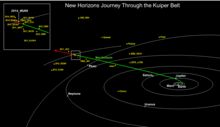2014 PN70
Synodic rotation period | 12.05 h[9] | |
| 0.04–0.10[7] 0.04–0.15[6] | ||
| V–I = 1.34[10] | ||
| 26.1[10] | ||
| 10.3[3] | ||
2014 PN70 (internally designated g12000JZ, g1 and PT3) is a
Discovery and designations

2014 PN70 was discovered by the
Orbit and classification
2014 PN70 is a
The body's
Numbering and naming
This minor planet has not been numbered by the Minor Planet Center and remains unnamed.[1]
Physical characteristics
2014 PN70, has a diameter approximately 35–55 km (22–34 mi), based on an estimated
Exploration


Having completed its flyby of
2014 PN70 is one of the objects that New Horizons observed from greater distances, as part of its extended Kuiper belt mission. The spacecraft passed 2014 PN70 in March 2019, at a distance of approximately 0.1 AU (15 million km; 9.3 million mi). This made 2014 PN70 the third closest KBO observed by New Horizons, after Arrokoth and 2014 OS393.[17] New Horizons made its first observations of 2014 PN70 on 5 January 2019, from a distance of 92.7 million km.[18]
New Horizons did not come close enough to resolve either 2014 PN70 or 2014 OS393, but the observations should be sufficient to determine the rotation periods and surface properties of these objects and to search for possible satellites. The distant KBO observations provide an important context for the data collected during the close flyby of Arrokoth.[19]
See also
References
- ^ a b c d e "2014 PN70". Minor Planet Center. Retrieved 9 February 2018.
- ^ a b c d Zangari, Amanda (28 March 2015). "Postcards from Pluto". Tumblr.
- ^ a b c "JPL Small-Body Database Browser: (2014 PN70)" (2014-10-22 last obs.). Jet Propulsion Laboratory. Retrieved 9 February 2018.
- Marc W. Buie. "Orbit Fit and Astrometric record for 14PN70". SwRI (Space Science Department). Retrieved 18 February 2018.
- ^ a b c Johnston, Wm. Robert (30 December 2017). "List of Known Trans-Neptunian Objects". Johnston's Archive. Retrieved 9 February 2018.
- ^ Buie, Marc (15 October 2014). "New Horizons HST KBO Search Results: Status Report" (PDF). Space Telescope Science Institute. p. 23. Archived from the original(PDF) on 27 July 2015.
- ^ Planetary Society. Archivedfrom the original on 15 October 2014.
- ^ a b "Asteroid Size Estimator". CNEOS NASA/JPL. Retrieved 9 February 2018.
- Bibcode:2021DPS....5330701V. 307.01.
- ^ S2CID 119192900.
- Bibcode:2015EPSC...10..417S.
- ^ "Hubble to Proceed with Full Search for New Horizons Targets". HubbleSite news release. Space Telescope Science Institute. 1 July 2014.
- ^ "NASA's Hubble Telescope Finds Potential Kuiper Belt Targets for New Horizons Pluto Mission". HubbleSite. 15 October 2014.
- ^ Wall, Mike (15 October 2014). "Hubble Telescope Spots Post-Pluto Targets for New Horizons Probe". Space.com. Archived from the original on 15 October 2014.
- ^ Powell, Corey S. (29 March 2015). "Alan Stern on Pluto's Wonders, New Horizons' Lost Twin, and That Whole "Dwarf Planet" Thing". Discover. Archived from the original on 16 November 2019. Retrieved 8 May 2015.
- ^ Cofield, Calla (28 August 2015). "Beyond Pluto: 2nd Target Chosen for New Horizons Probe". Space.com.
- S2CID 119506499.
- ^ "NH LORRI KEM1". pdssbn.astro.umd.edu. Planetary Data System. 18 October 2019. Retrieved 27 June 2020.
- ^ Alan Stern (14 April 2016). "To Boldly Go On, In the Service of Exploration". pluto.jhuapl.edu. Retrieved 22 September 2018.
External links
- OPAG: We Did It!, p.33, Presentation to the Outer Planets Assessment Group, Alan Stern
- 2014 PN70 at the JPL Small-Body Database

